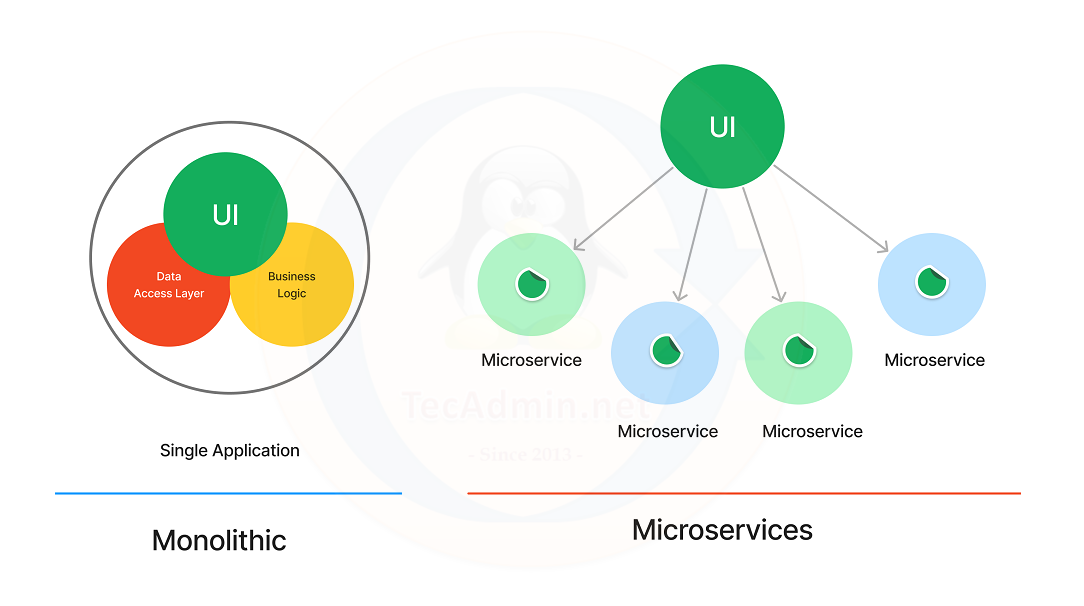In today’s rapidly evolving technological landscape, companies and developers aim to deliver robust, scalable, and easily maintainable applications. Enter “microservices”, a term that has gained significant traction over the last few years. But what are they, and why have they become so popular? In this article, we’ll delve into the world of microservices, explore their key principles and benefits, and compare them with their predecessor, the monolithic architecture.
What are microservices?
Microservices, also known as the microservice architecture, refer to an architectural style that structures an application as a collection of loosely coupled, independently deployable services. Each service, or “microservice”, is a small, focused component that performs a specific function and communicates with other services over standard protocols, often HTTP.
Imagine a large, intricate machine. Instead of being built as one massive, interdependent piece, it’s composed of many small, independent components. Each part has its specific job, and they work together harmoniously. That’s the essence of the microservice architecture – breaking down complex applications into manageable, modular parts.

Understand Microservices in Layman’s Style
Imagine you’re playing with LEGO blocks. Each LEGO block is unique and serves a particular purpose, but when you combine them, you can create amazing structures, from houses to spaceships. If one part of your creation breaks or you want to change it, you can easily replace or modify just that one LEGO block without having to tear apart the whole thing.
Now, let’s relate this to software. Traditional software is like building a big model out of one giant piece of clay. If you want to change a part, you often have to reshape a large portion, which can be messy and time-consuming.
Microservices are like the LEGO approach to building software. Instead of one massive program, you build an application as a collection of small services. Each microservice does one thing and does it well. Just like with LEGO blocks, you can update, replace, or add a new microservice without messing with the others.
Key Principles of the Microservices Architecture
- Single Responsibility Principle: Each microservice should have a single, clearly-defined purpose. For instance, one service might handle user authentication while another manages product inventory.
- Loose Coupling: Services should be as independent as possible. Changes to one service should not necessitate changes in others.
- Decentralized Governance: Teams have the flexibility to choose the best technologies and tools for their specific microservice, rather than being mandated a single tech stack for the entire application.
- Autonomous Deployment: Since each service is decoupled from others, they can be deployed, updated, and scaled independently. This is crucial for continuous deployment and integration.
- Infrastructure Automation: Microservices often come hand-in-hand with containerization tools (like Docker) and orchestration platforms (like Kubernetes) which allow for streamlined deployment, scaling, and management.
Benefits of Microservices
- Scalability: Individual services can be scaled separately based on demand. For instance, if an e-commerce platform sees increased activity in its payment gateway but not in product listings, only the payment microservice needs scaling.
- Resilience: A failure in one service doesn’t bring down the entire application. This isolation guarantees that localized issues remain localized.
- Faster Time to Market: Teams can develop, test, and deploy services independently, leading to quicker releases.
- Flexibility: Teams can choose the best technology stack for their specific service, rather than being constrained by the choices of the overall application.
- Optimized Maintenance: Smaller codebases for each service make troubleshooting and updates more manageable.
Comparison with Monolithic Architectures
Monolithic Architecture:
- Built as a single, unified unit. All functions – from user interface to data processing to backend tasks – are bundled into one codebase and run as a single service.
- Typically uses a single database for all its data storage needs.
- Changes, even minor ones, require the entire application to be rebuilt and redeployed.
Microservices Architecture:
- Comprises multiple small services, each running in its process and often with its own database.
- Services can be developed, deployed, and scaled independently.
- Enables the use of different technology stacks for different services, enhancing flexibility.

Which to Choose?
The choice between monolithic and microservices isn’t black and white. Startups and smaller applications might benefit from the simplicity and straightforward nature of a monolithic structure. However, as the application grows and scalability, resilience, and speed of deployment become critical, transitioning to a microservices architecture might be beneficial.
Conclusion
Microservices represent a shift in how developers think about application design, emphasizing modularity, scalability, and flexibility. As with any architectural choice, it comes with trade-offs. While microservices offer many benefits, they also introduce complexities in terms of service coordination, data consistency, and network reliance. As always, understanding the needs of the specific application and the team’s capabilities is key to making an informed decision.
